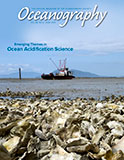Article Abstract
New England coastal and adjacent Nova Scotia shelf waters have a reduced buffering capacity because of significant freshwater input, making the region’s waters potentially more vulnerable to coastal acidification. Nutrient loading and heavy precipitation events further acidify the region’s poorly buffered coastal waters. Despite the apparent vulnerability of these waters, and fisheries’ and mariculture’s significant dependence on calcifying species, the community lacks the ability to confidently predict how the region’s ecosystems will respond to continued ocean and coastal acidification. Here, we discuss ocean and coastal acidification processes specific to New England coastal and Nova Scotia shelf waters and review current understanding of the biological consequences most relevant to the region. We also identify key research and monitoring needs to be addressed and highlight existing capacities that should be leveraged to advance a regional understanding of ocean and coastal acidification.

